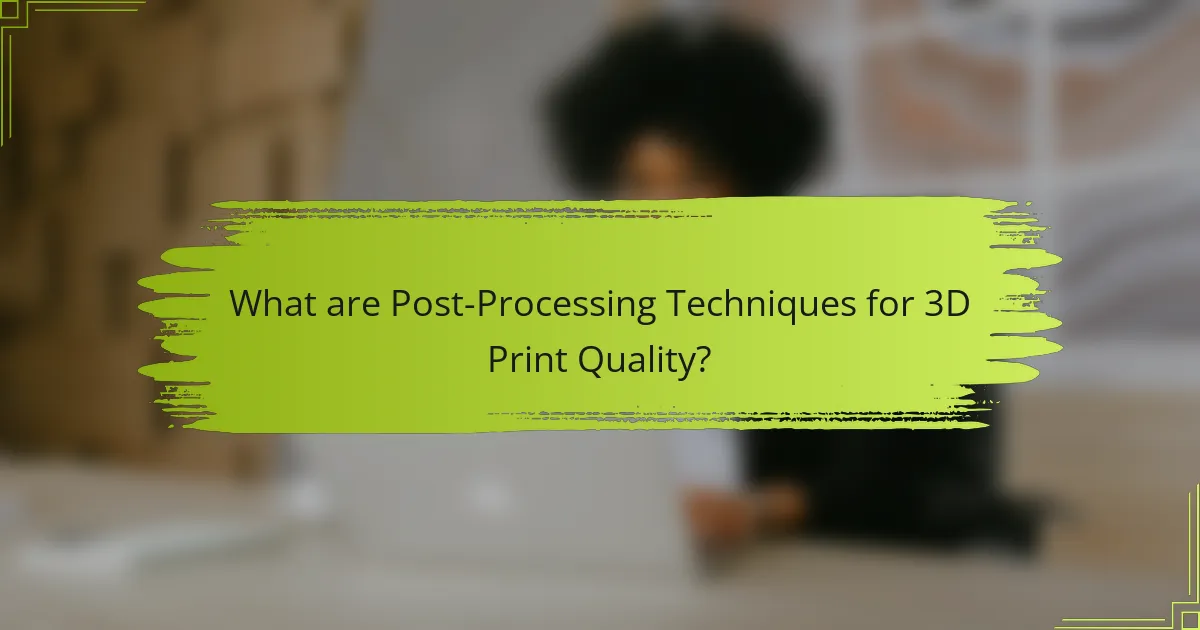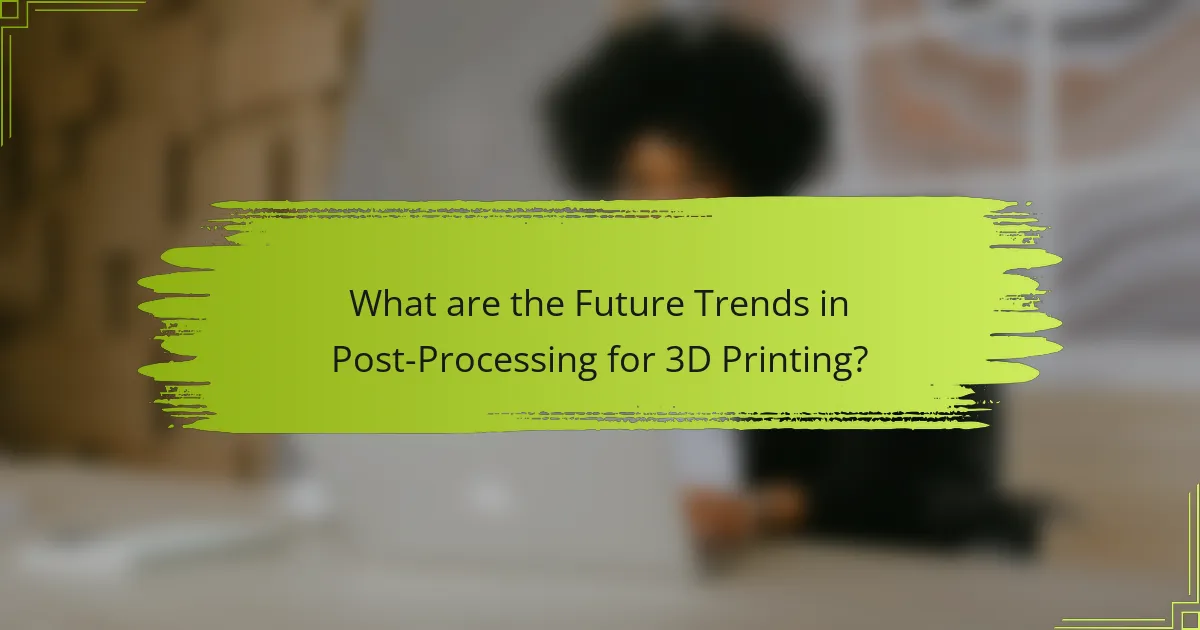
What are Post-Processing Techniques for 3D Print Quality?
Post-processing techniques for 3D print quality include sanding, painting, and chemical smoothing. Sanding removes surface imperfections and improves texture. Painting adds color and can enhance visual appeal. Chemical smoothing utilizes solvents to create a smoother finish. These techniques are essential for achieving a professional look. They also improve the overall durability of the printed object. Each method addresses specific quality issues commonly found in 3D prints. For instance, sanding is effective for layer lines, while chemical smoothing can reduce visible seams.
Why are Post-Processing Techniques Important for 3D Printing?
Post-processing techniques are important for 3D printing because they enhance the final quality of printed objects. These techniques address issues like surface finish, dimensional accuracy, and material properties. For instance, sanding and polishing can remove layer lines and improve aesthetics. Additionally, chemical smoothing can create a more uniform surface and increase strength. Techniques such as painting or coating add protection and visual appeal. Research indicates that post-processing can reduce porosity and improve mechanical performance. Therefore, post-processing is essential for achieving professional-grade 3D prints.
How do Post-Processing Techniques enhance the final product?
Post-processing techniques enhance the final product by improving surface finish, dimensional accuracy, and overall aesthetics. These techniques include sanding, painting, and chemical smoothing. Sanding removes layer lines and imperfections, resulting in a smoother surface. Painting adds color and can improve visual appeal. Chemical smoothing can eliminate rough textures by melting the surface slightly. According to a study by R. S. Lee et al. in the Journal of Manufacturing Processes, post-processing significantly increases the mechanical properties of 3D printed parts. Enhanced mechanical properties lead to improved durability and functionality. Overall, these techniques contribute to a more polished and professional final product.
What common challenges do Post-Processing Techniques address?
Post-processing techniques address common challenges such as surface finish quality, dimensional accuracy, and layer adhesion in 3D prints. These techniques enhance the aesthetic and functional properties of printed objects. For instance, sanding improves surface smoothness, while chemical treatments can remove visible layer lines. Additionally, post-processing can correct minor dimensional inaccuracies that occur during printing. Techniques like annealing can strengthen layer adhesion, reducing the risk of delamination. Overall, these methods are essential for achieving professional-grade results in 3D printing.
What are the Different Types of Post-Processing Techniques?
The different types of post-processing techniques for improving 3D print quality include sanding, painting, and vapor smoothing. Sanding removes surface imperfections and achieves a smoother finish. Painting enhances aesthetics and provides color options. Vapor smoothing uses solvents to create a glossy surface and reduce layer visibility. Other techniques include polishing, which adds shine, and dyeing, which alters the material color. Each technique addresses specific quality issues, enhancing the final product’s appearance and feel.
What techniques are used for surface finishing?
Techniques used for surface finishing include sanding, polishing, and painting. Sanding removes imperfections and smooths surfaces. Polishing enhances surface shine and smoothness. Painting adds color and protection to the finished product. Other techniques include vapor smoothing, which uses solvents to create a smooth surface, and chemical finishing, which alters surface properties at a microscopic level. These methods improve the aesthetic and functional qualities of 3D printed objects.
How does support removal impact print quality?
Support removal can significantly impact print quality. Inadequate support removal may leave residue on the print surface. This residue can result in an uneven finish and visible blemishes. Additionally, improper removal can damage delicate features of the print. For example, excessive force during support removal can lead to cracking or deformation. Furthermore, the quality of the support material itself influences the final appearance. If the support material adheres too strongly, it may pull away layers of the print. Ultimately, careful and precise support removal is essential for achieving high-quality 3D prints.
What Factors Influence the Choice of Post-Processing Techniques?
The choice of post-processing techniques is influenced by several factors. These factors include the type of material used in 3D printing. Different materials respond uniquely to various post-processing methods. The desired finish quality also plays a crucial role. Higher quality finishes may require more intensive techniques. Additionally, the complexity of the printed object affects the choice. Intricate designs may need specialized post-processing methods. The intended application of the printed part is another important factor. Functional parts may require specific treatments for durability. Cost and time constraints also influence the decision. Budget limitations can restrict the choice of techniques available. Finally, the skill level of the operator can determine which methods are feasible. Each of these factors must be considered to achieve optimal results in post-processing.
How do material properties affect post-processing decisions?
Material properties significantly influence post-processing decisions. Different materials exhibit unique characteristics such as strength, flexibility, and thermal stability. For example, thermoplastics may require specific cooling rates to avoid warping. Metals often need heat treatment to enhance mechanical properties. The surface finish desired also depends on the material; some materials respond better to sanding or polishing. Additionally, chemical resistance varies among materials, affecting the choice of solvents for cleaning. Understanding these properties ensures effective post-processing methods are selected. This alignment between material characteristics and post-processing techniques optimizes the final quality of 3D printed objects.
What role does the intended use of the print play in technique selection?
The intended use of the print significantly influences technique selection. Different applications require varying levels of detail, strength, and finish. For instance, functional parts may need techniques that enhance durability, such as annealing or coating. Decorative prints, on the other hand, may prioritize surface finish and color, leading to techniques like sanding or painting. The material used also affects the choice of post-processing methods. For example, thermoplastics may respond well to heat treatments, while resin prints require UV curing. Ultimately, aligning the technique with the intended use ensures optimal performance and aesthetics of the final product.

How Can Post-Processing Techniques Be Effectively Implemented?
Post-processing techniques can be effectively implemented by following a systematic approach. This involves selecting appropriate methods based on the specific material and print quality desired. Techniques such as sanding, polishing, and painting can enhance surface finish. Chemical smoothing can reduce layer lines and improve aesthetics. Additionally, heat treatment can increase strength and durability. Each technique should be tested on a small scale before full application. This ensures compatibility with the printed material. Research indicates that these methods can significantly enhance the final quality of 3D printed objects. For example, a study published in the Journal of Manufacturing Processes found that post-processing improved surface roughness by up to 50%.
What are the Best Practices for Applying Post-Processing Techniques?
Best practices for applying post-processing techniques include careful planning and methodical execution. Start by assessing the specific needs of the 3D print. Techniques such as sanding, painting, and chemical smoothing should be chosen based on the material and desired finish. Ensure proper safety measures are in place when using chemicals or tools. Test techniques on sample prints before applying them to final pieces. Maintain consistent pressure and motion when sanding or polishing to avoid uneven surfaces. Document the process for future reference and improvements. Quality control checks should be performed after each technique to ensure desired outcomes are achieved.
How can one ensure consistency in post-processing results?
To ensure consistency in post-processing results for 3D printing, one should standardize techniques and parameters. This includes maintaining uniform temperatures, exposure times, and material types across different batches. Using the same equipment and tools for each step also contributes to consistent outcomes. Regular calibration of machines ensures that they operate within specified tolerances. Documenting every process step allows for replication and troubleshooting if inconsistencies arise. Implementing quality control checks at various stages helps identify deviations early. Studies show that controlled environments reduce variability, leading to more reliable post-processing results.
What tools and equipment are essential for effective post-processing?
Essential tools and equipment for effective post-processing include sanders, files, and paintbrushes. Sanders are used for smoothing surfaces and removing imperfections. Files help refine edges and details. Paintbrushes apply finishes evenly. Additionally, a heat gun can assist in shaping and smoothing materials. A cutting tool is vital for trimming excess material. Safety equipment, like gloves and masks, ensures user protection. These tools collectively enhance the quality of 3D printed objects through precise finishing techniques.
What Common Mistakes Should Be Avoided in Post-Processing?
Common mistakes in post-processing 3D prints include over-sanding, which can damage the surface detail. Another mistake is using the wrong type of adhesive, leading to poor bonding. Failing to properly clean the print before applying finishes can result in uneven textures. Rushing the curing process can weaken the final product. Not testing finishes on a sample piece may lead to undesirable results. Ignoring safety precautions, such as ventilation, can pose health risks. Lastly, neglecting to calibrate tools can affect accuracy and quality. These mistakes can compromise the integrity and appearance of 3D prints.
How can improper techniques affect the final print quality?
Improper techniques can significantly degrade final print quality. Common issues include poor layer adhesion, leading to weak structures. Inadequate post-processing can result in visible layer lines. Incorrect curing times may cause warping or deformation. Using unsuitable materials can lead to color inconsistencies. Improper sanding or finishing can create rough surfaces. These factors collectively diminish the aesthetic and functional properties of the print.
What are the signs of inadequate post-processing?
Signs of inadequate post-processing include visible layer lines and rough surfaces on the print. These imperfections indicate insufficient smoothing or finishing techniques. Additionally, poor adhesion between layers can lead to structural weaknesses. This may manifest as cracks or delamination in the final product. Inconsistent color or texture can also signal inadequate post-processing. These issues often arise from improper painting or coating methods. Lastly, a lack of detail in intricate areas suggests that post-processing did not enhance the print effectively. These signs collectively demonstrate the need for improved post-processing techniques to achieve higher quality in 3D prints.

What are the Future Trends in Post-Processing for 3D Printing?
Future trends in post-processing for 3D printing include automation, advanced surface finishing, and improved material compatibility. Automation will streamline processes, reducing labor costs and increasing efficiency. Advanced surface finishing techniques, such as chemical smoothing and laser polishing, will enhance aesthetics and mechanical properties. Improved material compatibility will allow for better integration of post-processing methods with various 3D printing materials. Additionally, the use of artificial intelligence will optimize post-processing workflows. These trends are driven by the demand for higher quality and more complex 3D printed parts across industries.
How is Technology Advancing Post-Processing Techniques?
Technology is advancing post-processing techniques by integrating automation and advanced software solutions. Automated systems reduce human error and increase efficiency in post-processing tasks. Advanced software allows for precise control over parameters like temperature and pressure during processes such as curing and polishing. Innovations in robotics enable faster handling and manipulation of 3D printed parts. Machine learning algorithms optimize post-processing workflows by predicting the best methods for specific materials and designs. Additionally, new materials are being developed that require less intensive post-processing, streamlining the overall production process. These advancements collectively enhance the quality and consistency of 3D printed products.
What innovations are being introduced in post-processing equipment?
Innovations in post-processing equipment for 3D printing include advanced automated systems and new material treatments. Automated systems enhance efficiency by reducing manual labor in finishing processes. Techniques such as chemical smoothing and vapor polishing improve surface quality significantly. New technologies like laser engraving and UV curing enable precise detailing and faster curing times. Additionally, the integration of AI in monitoring post-processing helps optimize parameters in real-time. These innovations lead to higher quality prints with reduced turnaround times. Recent studies show that these advancements can increase production rates by up to 30%.
How might automation change the landscape of post-processing?
Automation will significantly enhance post-processing in 3D printing. It will streamline workflows, reducing manual labor and time. Automated systems can perform tasks like sanding, painting, and assembly with precision. This leads to consistent quality and fewer human errors. According to a study by Wohlers Associates, automation can decrease post-processing time by up to 50%. Furthermore, automation allows for scalability in production, accommodating increased demand without compromising quality. Overall, automation will transform post-processing into a more efficient and reliable process in 3D printing.
What Practical Tips Can Help Improve Post-Processing Results?
To improve post-processing results in 3D printing, focus on specific techniques. First, ensure proper surface preparation by sanding or filing rough edges. This enhances the final appearance and feel of the print. Second, use the right adhesives for assembling parts. Strong adhesives ensure durability and stability. Third, apply appropriate finishing techniques such as painting or coating. This adds aesthetic value and can protect the print. Fourth, consider using heat treatment to relieve internal stresses. This can prevent warping and improve overall strength. Lastly, experiment with different post-processing methods to find the most effective combination for your specific material and design. These techniques are supported by industry practices that emphasize the importance of preparation and finishing in achieving high-quality 3D prints.
How can users experiment with different techniques for better outcomes?
Users can experiment with different post-processing techniques to improve 3D print quality by systematically applying methods such as sanding, painting, or using chemical smoothing. Each technique alters the surface finish and overall appearance of the print. For example, sanding can remove layer lines and create a smoother finish. Painting can enhance aesthetics and provide a protective layer. Chemical smoothing, using substances like acetone for ABS prints, can dissolve surface imperfections. Users should document the outcomes of each technique. This documentation allows for comparison and identification of the most effective methods. Research shows that iterative experimentation leads to optimal results in print quality.
What resources are available for learning more about post-processing methods?
Resources for learning about post-processing methods include online courses, tutorials, and books. Websites like Coursera and Udemy offer structured courses on 3D printing techniques. YouTube hosts numerous video tutorials demonstrating various post-processing methods. Forums like Reddit and specialized 3D printing communities provide user experiences and tips. Books such as “3D Printing: A Practical Guide to Technology and Techniques” offer in-depth knowledge. Research articles from journals like “Additive Manufacturing” present the latest findings in post-processing methods. These resources collectively enhance understanding and application of post-processing techniques in 3D printing.
Post-processing techniques are essential methods used to enhance the quality of 3D printed objects. These techniques include sanding, painting, and chemical smoothing, which address common challenges such as surface finish, dimensional accuracy, and material properties. The article explores various types of post-processing methods, their importance in achieving professional-grade results, and the factors influencing technique selection. Additionally, it discusses best practices, common mistakes to avoid, and future trends in post-processing technology, providing readers with a comprehensive understanding of how to optimize the quality of 3D prints.